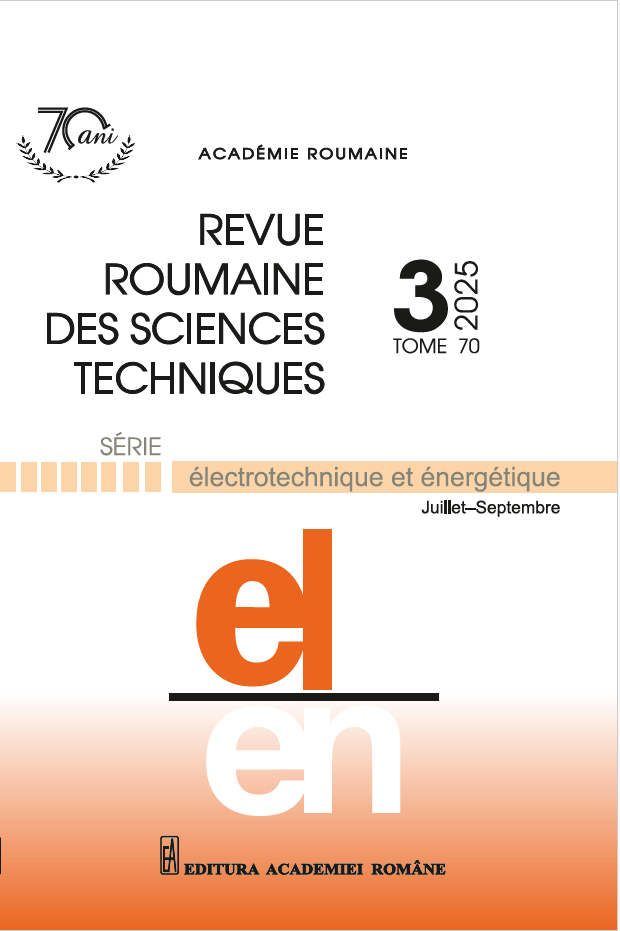ROBUST WIND POWER CONTROL USING SLIDING MODE, BACKSTEPPING, AND FUZZY LOGIC
DOI:
https://doi.org/10.59277/RRST-EE.2025.3.5Keywords:
Doubly fed induction generator, Sliding mode control, Backstepping control, Fuzzy logic, Hybrid, Power controlAbstract
This paper presents a novel nonlinear control approach for a doubly fed induction generator (DFIG) by integrating sliding mode control, backstepping control, and fuzzy logic. The proposed hybrid strategy modifies the sliding mode controller by retaining the equivalent control while replacing the attractive control with backstepping. Type-1 fuzzy logic is then used to optimize the stabilization gains of the backstepping controller, enhancing system stability and resilience. The effectiveness of the proposed control is evaluated through MATLAB/Simulink simulations. Results from the tracking test show accurate reference trajectory tracking without exceeding active and reactive power limits or exhibiting steady-state errors. In the regulation test, the system demonstrated sensitivity to sudden speed changes but maintained stable active and reactive power.
References
(1) R. Rouabhi, A. Herizi, A. Djerioui, Performance of robust type-2 fuzzy sliding mode control compared to various conventional controls of doubly-fed induction generator for wind power conversion systems, Energies, 17, 3778, pp. 1–25 (2024).
(2) E. Farah, Y. Ihedrane, B. Bossouf, M. Bouderbala, S. Motahhir, M. Masud, S. Aljahdali, M. El Ghamrasni, Robust sliding Backstepping mode control of a wind system based on the DFIG generator, Scientifc Reports, 12, 11782, pp. 1–16 (2022).
(3) S. Kouadria, E. Berkouk, Y. Messlem, M, Denai, Improved control strategy of DFIG-based wind turbines using direct torque and direct power control techniques, Journal of. Renewable and Sustainable Energy, 10, 4, pp. 1–21, (2018).
(4) C.R. Raghavendran, J.P. Roselyn, D. Devaraj, Development and performance analysis of intelligent fault ride through controls chemein the dynamic behaviour of grid connected DFIG based wind systems, Energy Reports, 6, pp. 2560–2576 (2020).
(5) B. Desalegn, D. Gebeyehu, B. Tamrat, Wind energy conversion technologies and engineering approaches to enhancing wind power generation, Heliyon, 8, pp. 1–21 (2022).
(6) Y. Sahri, S. Tamalouzt, S.L. Belaid, M. Bajaj, S.S. Ghoneim, H.M. Zawbaa, S. Kamel, Performance improvement of Hybrid System-based DFIG-Wind/PV/Batteries connected to DC and AC grid by applying Intelligent Control, Energy Reports, 9, pp. 2027–2043 (2023).
(7) R. Rouabhi, A. Herizi, S. Djeriou, A. Zemmit, Hybrid type-1 and 2 fuzzy sliding mode control of the induction motor, Revue Roumaine des Sciences Techniques, Série Électrotechnique et Énergétique, 69, 2, pp. 147–152 (2024).
(8) C. Hamid, A. Derouich, M. Taoussi, O. Zamzoum, A. Hanafi, An improved performance variable speed wind turbine driving a doubly fed induction generator using sliding mode strategy. IEEE 2nd International Conference on Electronics, Control, Optimization and Computer Science (ICECOCS), Kenitra, Morocco, (2020).
(9) B. Kelkoul, A. Boumediene, Stability analysis and study between classical sliding mode control (SMC) and super twisting algorithm (STA) for doubly fed induction generator (DFIG) under wind turbine, Energy, 214 (2021).
(10) A. Herizi, R. Rouabhi, A. Zemmit, Comparative study of the performance of a sliding, sliding-fuzzy type 1 and a sliding-fuzzy type 2 control of a permanent magnet synchronous machine, Przegląd Elektrotechniczny, 98, 11, pp. 21–29 (2022).
(11) A. Ghalem, A. Naceri, Y. Djeriri, Backstepping control of a wind energy conversion system based on a DFIG connected to the grid, Przegląd Elektrotechniczny, 99, 12, pp. 98–103 (2023).
(12) A. Herizi, R. Rouabhi, A. Zemmit, Speed control of doubly fed induction motor using backstepping control with interval type-2 fuzzy controller, Diagnostyka, 24, 3, pp. 1-8 (2023).
(13) A. Herizi, A. Benyounes, R. Rouabhi, A. boudras, F. Ouagueni, A. Zemmit, Robust fuzzy – backstepping mode control of an induction motor, Studies in Engineering and Exact Sciences, 5, 1, pp. 1317-1334 (2024).
(14) A. Benyounes, A. Herizi, M. Zegait, M. Bouras, B. Nail, I.E. Tibermacine, Fuzzy backstepping control for enhanced stability of a quadrotor unmanned aerial vehicle, Studies in Engineering and Exact Sciences, 5, 1, pp. 746-769 (2024).
(15) C. Dualibe, M. Verleysen, P.G.A. Jespers, Design of analog fuzzy logic controllers in CMOS technologies, Kluwer Academic Publishers, New York (2003).
(16) R. Lowen, A. Verschoren, Foundations of generic optimization, Volume 2: applications of fuzzy control, genetic algorithms and neural networks, Springer (2008).
(17) M. Errouha, A. Derouich et al., Optimization and control of water pumping PV systems using fuzzy logic controller, Energy Reports, 5, pp. 853–865 (2019).
(18) M.S. Adouairi, B. Bossoufi, S. Motahhir, I. Saady, Application of fuzzy sliding mode control on a single-stage grid-connected PV system based on the voltage-oriented control strategy, Results in Engineering, 17, pp. 1–9 (2023).
(19) A.J.G. Malar, C.A. Kumar, A.G. Saravanan, Iot based sustainable wind green energy for smart cities using fuzzy logic based fractional order darwinian particles warm optimization, Measurement, 166 (2020).
(20) A. Herizi, A. Zemmit, R. Rouabhi, F. Ouagueni, New design of robust controller based on fuzzy 12 linguistic variables for wind power conversion system, Przegląd Elektrotechniczny, 100, 10, pp. 89–92 (2024).
(21) H.H.H. Mousa, A. Youssef, E.E.M. Mohamed, Hybrid and adaptive sectors P&O MPPT algorithm based wind generation system, Renewable Energy, 145, pp. 1412-1429 (2020).
(22) M. Ahmad Soomro, Z. Ahmad Memon, M. Kumar, M. Hussain Baloch, Wind energy integration: Dynamic modeling and control of DFIG based on super twisting fractional order terminal sliding mode controller, Energy Reports, 7, pp. 6031-6043 (2021).
(23) A. Herizi, R. Rouabhi, S. Krim, E. Hachi, Hybrid control using fuzzy sliding mode control of doubly fed induction machine, Oum El Bouaghi, Algeria (2021).
Downloads
Published
Issue
Section
License
Copyright (c) 2025 REVUE ROUMAINE DES SCIENCES TECHNIQUES — SÉRIE ÉLECTROTECHNIQUE ET ÉNERGÉTIQUE

This work is licensed under a Creative Commons Attribution-NonCommercial-NoDerivatives 4.0 International License.


